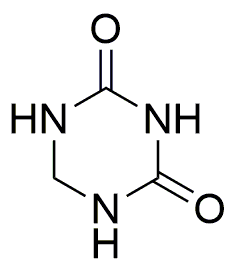1,3,5-Triazinane-2,4-dione is widely utilized in research focused on:
- Agricultural Chemicals: This compound serves as a precursor in the synthesis of herbicides and pesticides, helping to enhance crop yields and protect plants from pests.
- Pharmaceuticals: It is used in the development of various medicinal compounds, particularly in creating drugs that target specific biological pathways, improving therapeutic efficacy.
- Polymer Chemistry: The compound acts as a building block in the production of polymers, contributing to materials with enhanced durability and chemical resistance, which are essential in various industrial applications.
- Analytical Chemistry: It is employed in analytical methods for detecting and quantifying other compounds, providing researchers with reliable data for quality control and research purposes.
- Environmental Science: The compound is explored for its potential in remediation processes, aiding in the breakdown of pollutants and contributing to environmental sustainability efforts.
Informations générales
Propriétés
Sécurité et réglementation
Applications
1,3,5-Triazinane-2,4-dione is widely utilized in research focused on:
- Agricultural Chemicals: This compound serves as a precursor in the synthesis of herbicides and pesticides, helping to enhance crop yields and protect plants from pests.
- Pharmaceuticals: It is used in the development of various medicinal compounds, particularly in creating drugs that target specific biological pathways, improving therapeutic efficacy.
- Polymer Chemistry: The compound acts as a building block in the production of polymers, contributing to materials with enhanced durability and chemical resistance, which are essential in various industrial applications.
- Analytical Chemistry: It is employed in analytical methods for detecting and quantifying other compounds, providing researchers with reliable data for quality control and research purposes.
- Environmental Science: The compound is explored for its potential in remediation processes, aiding in the breakdown of pollutants and contributing to environmental sustainability efforts.
Documents
Fiches de données de sécurité (FDS)
La FDS fournit des informations de sécurité complètes sur la manipulation, le stockage et l’élimination du produit.
Spécifications du produit (PS)
Le PS fournit une description complète des propriétés du produit, notamment sa composition chimique, son état physique, sa pureté et les exigences de stockage. Il détaille également les plages de qualité acceptables et les applications prévues du produit.
Certificats d'analyse (COA)
Recherchez des certificats d'analyse (COA) en saisissant le numéro de lot du produit. Les numéros de lot et de lot se trouvent sur l'étiquette d'un produit, après les mots « Lot » ou « Lot de fabrication ».
Numéro de catalogue
Numéro de lot/série
Certificats d'origine (COO)
Ce certificat d'exploitation confirme le pays dans lequel le produit a été fabriqué, et détaille également les matériaux et composants utilisés et s'il est issu de sources naturelles, synthétiques ou autres sources spécifiques. Ce certificat peut être requis pour les douanes, le commerce et la conformité réglementaire.
Numéro de catalogue
Numéro de lot/série
Fiches de données de sécurité (FDS)
La FDS fournit des informations de sécurité complètes sur la manipulation, le stockage et l’élimination du produit.
DownloadSpécifications du produit (PS)
Le PS fournit une description complète des propriétés du produit, notamment sa composition chimique, son état physique, sa pureté et les exigences de stockage. Il détaille également les plages de qualité acceptables et les applications prévues du produit.
DownloadCertificats d'analyse (COA)
Recherchez des certificats d'analyse (COA) en saisissant le numéro de lot du produit. Les numéros de lot et de lot se trouvent sur l'étiquette d'un produit, après les mots « Lot » ou « Lot de fabrication ».
Numéro de catalogue
Numéro de lot/série
Certificats d'origine (COO)
Ce certificat d'exploitation confirme le pays dans lequel le produit a été fabriqué, et détaille également les matériaux et composants utilisés et s'il est issu de sources naturelles, synthétiques ou autres sources spécifiques. Ce certificat peut être requis pour les douanes, le commerce et la conformité réglementaire.


